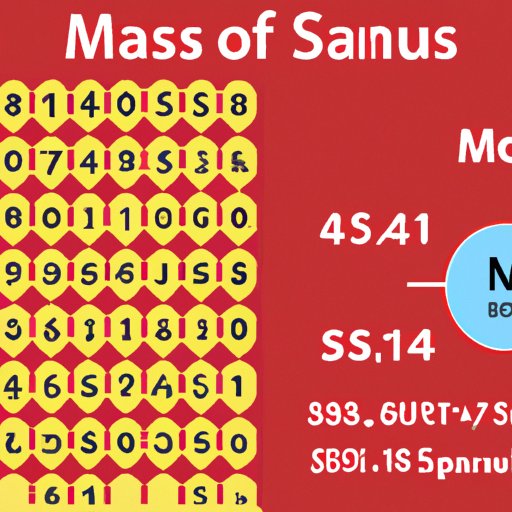Introduction
Understanding atomic properties is an essential part of the study of chemistry. One of the key properties of atoms is their mass number, which can be challenging to find at times. In this article, we will go over the basics of mass number and how to calculate it for various elements. We’ll also take a look at isotopes and explain how they affect atomic properties. Finally, we’ll offer readers some practice problems so that they can check their understanding of the material.
What is Mass Number?
Mass number is the total number of protons and neutrons in the nucleus of an atom. It is essential in understanding the physical and chemical properties of elements. Mass number is not to be confused with atomic number, which is the number of protons in an atom’s nucleus.
Calculating Mass Number for Elements
Calculating mass number for an element is a vital part of any chemistry class. The number of protons in an atom’s nucleus determines an element’s atomic number, while the number of neutrons and protons in the nucleus determines the element’s mass number. To determine the mass number for an element, we need to add the number of protons and neutrons in its nucleus. This information is readily available from the periodic table.
For example, let’s consider sodium (Na), which has 11 protons and 12 neutrons. Therefore, the mass number of sodium can be calculated as:
Mass number = Number of protons + Number of neutrons
Mass number = 11 + 12
Mass number = 23
Thus, the mass number of an element, in this case, sodium, is the sum of its protons and neutrons.
Example Problems
Here are some step-by-step examples of how to calculate mass number for a few common elements:
Example 1: Nitrogen (N)
Nitrogen has an atomic number of 7 and a mass number of 14. Calculate the number of neutrons in its nucleus.
Number of neutrons = Mass number – Number of protons
Number of neutrons = 14 – 7
Number of neutrons = 7
Example 2: Carbon (C)
Carbon has 6 protons and 6 neutrons. Find its mass number.
Mass number = Number of protons + Number of neutrons
Mass number = 6 + 6
Mass number = 12
Example 3: Oxygen (O)
Oxygen has an atomic number of 8 and a mass number of 16. Determine the number of neutrons present in its nucleus.
Number of neutrons = Mass number – Number of protons
Number of neutrons = 16 – 8
Number of neutrons = 8
Once we have the number of neutrons, we can quickly calculate an element’s mass number using the formula: Mass number = number of neutrons + number of protons.
Isotopes and Mass Number
Isotopes are atoms of the same element that have a different number of neutrons. For example, there are three isotopes of hydrogen – protium, deuterium, and tritium. Protium has no neutrons, while deuterium has one neutron, and tritium has two neutrons. Because isotopes have different numbers of neutrons, they also have different mass numbers.
The concept of isotopes plays a significant role in understanding atomic properties. The different isotopes of an element have the same atomic number, meaning they have the same number of protons in their nucleus. Because the number of electrons in an atom is equal to the number of protons, isotopes of the same element have the same electron configuration and the same chemical behavior.
However, isotopes of an element have a different number of neutrons, which means their mass numbers are different. For example, there are two isotopes of carbon – carbon-12 and carbon-14. Both isotopes have six protons and six electrons, but carbon-12 has six neutrons, while carbon-14 has eight neutrons.
Practice Problems
Here are some practice problems to help you solidify your understanding of mass number:
Practice Problem 1:
How many neutrons does an atom of potassium-39 have? (Atomic number of potassium is 19)
Practice Problem 2:
What is the mass number of an atom of chlorine with 17 protons and 20 neutrons?
Practice Problem 3:
What is the mass number of an isotope of uranium with 146 neutrons and 92 protons?
Conclusion
In conclusion, mass number is the total number of protons and neutrons in an atom’s nucleus, and it plays a crucial role in understanding atomic properties of elements. We’ve covered how to calculate mass number for various elements, explaining the respective roles of protons, neutrons, and electrons in determining a given element’s mass number. We’ve taken a close look at isotopes and their impact on mass number and atomic properties. Finally, we’ve offered readers practice problems to test their understanding of how to find mass numbers. With a solid grasp of these concepts, you’ll be on your way to a more profound understanding of atomic properties and chemistry as a whole.
